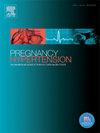Management of hypertension in the early postpartum: A randomized controlled trial
IF 2.9
4区 医学
Q2 OBSTETRICS & GYNECOLOGY
Pregnancy Hypertension-An International Journal of Womens Cardiovascular Health
Pub Date : 2025-01-29
DOI:10.1016/j.preghy.2025.101195
引用次数: 0
Abstract
Objectives
To evaluate blood pressure control during the immediate postpartum period in hypertensive women who had used methyldopa during pregnancy, comparing continuation of that drug with switching it for captopril.
Study design
A single-blind, randomized clinical trial involving 172 postpartum women with hypertension who had previously used methyldopa during pregnancy at a minimum dose of 750 mg/day for at least one week prior to delivery. The subtypes of hypertension included were gestational hypertension, chronic hypertension, preeclampsia, superimposed preeclampsia, HELLP syndrome and eclampsia. Following delivery, the patients were randomized either to continue with methyldopa at a minimum dose of 250 mg, three times a day (methyldopa group, n = 88) or to switch to captopril at an initial dose of 25 mg, three times a day (captopril group, n = 84).
Main outcome measures
Logistic regression was used to compare the groups regarding the potential to maintain blood pressure below 140/90 mmHg at over 50 % of measurements postpartum.
Results
In the 48 h following delivery, no significant differences were found between the groups regarding blood pressure control (methyldopa 92.0% versus captopril 95.2%), side effects, postpartum depression (Edinburgh Postnatal Depression Scale) or other clinical outcomes (hypertensive peaks, time to blood pressure control, additional medication use, or maternal and neonatal complications).
Conclusion
Continuation of antihypertensive treatment with methyldopa in the postpartum period yielded similar results to switching it for captopril, both with regard to the efficacy in controlling blood pressure and the safety of the treatment.
产后早期高血压的管理:一项随机对照试验。
目的:评价妊娠期间使用甲基多巴的高血压妇女产后血压控制情况,比较继续使用甲基多巴和改用卡托普利的情况。研究设计:一项单盲、随机临床试验,涉及172名产后高血压妇女,她们在怀孕期间至少在分娩前一周服用甲基多巴,最低剂量为750 mg/天。高血压的亚型包括妊娠期高血压、慢性高血压、子痫前期、叠加性子痫前期、HELLP综合征和子痫。分娩后,患者被随机分为两组,一组继续服用最低剂量为250 mg,每天3次的甲基多巴(甲基多巴组,n = 88),另一组改用起始剂量为25 mg,每天3次的卡托普利(卡托普利组,n = 84)。主要结局指标:采用Logistic回归比较两组在产后50%以上测量值中维持血压低于140/90 mmHg的可能性。结果:在分娩后48小时,两组在血压控制(甲基多巴92.0% vs卡托普利95.2%)、副作用、产后抑郁(爱丁堡产后抑郁量表)或其他临床结果(高血压峰值、血压控制时间、额外药物使用或孕产妇和新生儿并发症)方面无显著差异。结论:产后继续使用甲基多巴降压治疗与改用卡托普利降压的效果相似,无论是控制血压的效果还是治疗的安全性。
本文章由计算机程序翻译,如有差异,请以英文原文为准。
求助全文
约1分钟内获得全文
求助全文
来源期刊

Pregnancy Hypertension-An International Journal of Womens Cardiovascular Health
OBSTETRICS & GYNECOLOGYPERIPHERAL VASCULAR-PERIPHERAL VASCULAR DISEASE
CiteScore
4.90
自引率
0.00%
发文量
127
期刊介绍:
Pregnancy Hypertension: An International Journal of Women''s Cardiovascular Health aims to stimulate research in the field of hypertension in pregnancy, disseminate the useful results of such research, and advance education in the field.
We publish articles pertaining to human and animal blood pressure during gestation, hypertension during gestation including physiology of circulatory control, pathophysiology, methodology, therapy or any other material relevant to the relationship between elevated blood pressure and pregnancy. The subtitle reflects the wider aspects of studying hypertension in pregnancy thus we also publish articles on in utero programming, nutrition, long term effects of hypertension in pregnancy on cardiovascular health and other research that helps our understanding of the etiology or consequences of hypertension in pregnancy. Case reports are not published unless of exceptional/outstanding importance to the field.
 求助内容:
求助内容: 应助结果提醒方式:
应助结果提醒方式:


